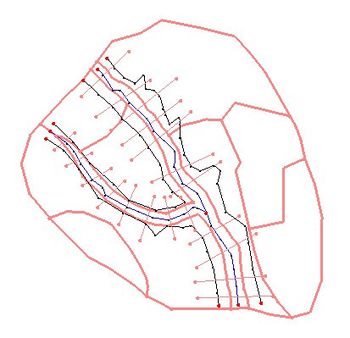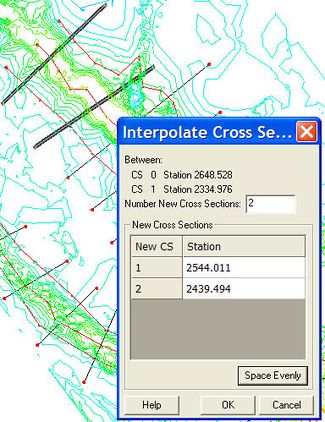WMS:River Tools
The River Tools provides the tools and commands necessary to build 1D Hydraulic modeling data from feature object coverages. The River Tools primarily support the HEC-RAS model, but will be used to support the FHWA BriStars model as well as additional hydraulic models that will be supported in future versions.
The River Tools provides the ability to define a hydraulic model using a 1D-Hydraulic Centerline coverage and a 1D-Hydraulic Cross Section coverage. The layout of the feature objects defining the centerline and cross sections establishes the direction, the stationing, and the topology (connectivity between cross sections) of a hydraulic model. Further, using these two coverages cross sections may be automatically extracted from a digital terrain model and then edited, merged, or combined with other cross section information to provide the geometric basis of the model. An area property coverage can also be used to map materials (Manning's roughness coefficients) to the cross section based on some type of aerial distinction (land use or soils) that may be available. The diagram below illustrates how these coverages are used to establish a hydraulic model.
The River Tools also allows interpolating cross sections to establish more cross section information in between surveyed or extracted cross sections.
Results data from HEC-RAS and other hydraulic models can be read back in and used to perform a floodplain delineation. The floodplain delineation algorithm in WMS works better with a denser set of resulting water surface elevation points and so there are river tools that allow a water surface elevation computed at a cross section to be interpolated (copied since it will be the same value) along cross section arcs, or along a centerline.
River Tools Menu
The River Tools menu has the following commands:
- Recompute All Stations
- Updates river station information for the 1D Hydraulic Centerline and the 1D Hydraulic Cross Section coverages. Use this command if any changes have been made to centerline arcs in the 1D Hydraulic Centerline coverage that change the cross section stations in the 1D Hydraulic Cross Section coverage. For example, if there are some cross sections with negative station values, using this command should fix the cross section stations. To update the cross section stations, first use this command in the 1D Hydraulic Centerline coverage and then use this command in the 1D Hydraulic Cross Section coverage. This will insure the cross section stations are set to the correct values. In the 1D Hydraulic Centerline coverage, this command recomputes the length and stationing along any centerline arcs. In the 1D Hydraulic Cross Section coverage, this command recomputes the cross section stations.
- Extract Cross Sections
- Uses the cross section arcs and a digital terrain model (TINs are the only source that can currently be used) to extract the elevations at vertices of the feature arc cross sections, or at the intersection points with the triangles. See Extract Cross Sections.
- Interpolate Cross Sections
- Creates any number of additional cross sections between two selected cross sections. This can provide more detail to the hydraulic model. The interpolated cross sections are derived from the geometries of the selected cross sections. The stationing of the new cross sections are established by evenly distributing the length between the selected cross sections. New feature arcs are created for the interpolated cross sections.
- Map → 1D Schematic
- Creates a hydraulic schematic based on the configuration of the arcs and nodes in a 1D Hydraulic Centerline coverage. If a schematic already exists for this coverage, the existing schematic is updated based on the coverage configuration.
- Interpolate Water Surface Elevations
- Interpolate, for either the 1D Hydraulic Centerline or 1D Hydraulic Cross Sections coverages, new scatter points either at the vertices of the feature arcs (centerline or cross sections) or at a specified distance along the arcs. See Interpolating Hydraulic Model Results.
- Interpolate Downstream from Selected Arcs
- Manage Cross Sections
- Allows creating a new database or opening an existing database to add geometries, edit existing ones, and provide proper georeferencing information. See Managing Cross Sections.
- Cross Sections → TIN
- Creates a new TIN using the cross section data in the 1D Hydraulic Cross Section coverage.
- Bridge/Culvert Points → Cross Sections
- Converts cross section data contained in a bridge/culvert point shapefile. The shapefile must be imported into WMS before using this command.
Related Topics
- 1D-Hydraulic Centerline
- 1D-Hydraulic Cross Section
- Area Property
- Extracting Cross Sections
- Hydraulic Modeling
- Floodplain Delineation
| [hide] WMS – Watershed Modeling System | ||
|---|---|---|
| Modules: | Terrain Data • Drainage • Map • Hydrologic Modeling • River • GIS • 2D Grid • 2D Scatter |  |
| Models: | CE-QUAL-W2 • GSSHA • HEC-1 • HEC-HMS • HEC-RAS • HSPF • MODRAT • NSS • OC Hydrograph • OC Rational • Rational • River Tools • Storm Drain • SMPDBK • SWMM • TR-20 • TR-55 | |
| Toolbars: | Modules • Macros • Units • Digitize • Static Tools • Dynamic Tools • Drawing • Get Data Tools | |
| Aquaveo | ||

